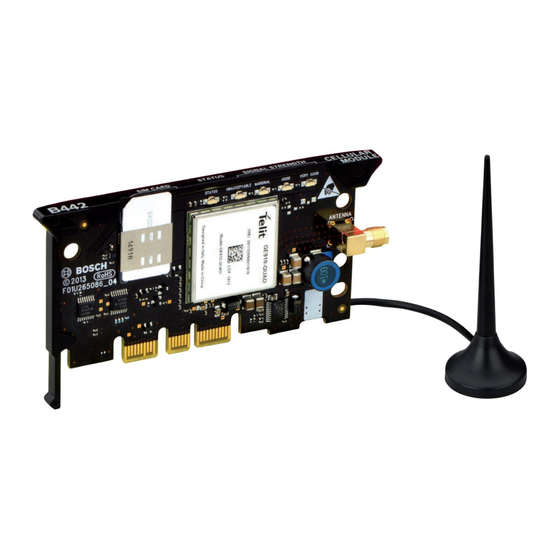Advertisement
Quick Links
1 | Overview
The B442 provides IP communication over the GSM (GPRS)
digital cellular network by directly connecting the module to the
control panel. The control panel can be confi gured to use B442
for alarm reporting, remote access and personal notifi cation
messaging.
The B442 module requires a SIM card with active cellular
service to communicate. Bosch Cellular service and SIM
cards are available in some countries. Consult your Bosch
representative for details.
1
2
3
5
1
6
Figure 1.1: Board overview
Callout ― Description
1 ― Module handle and support leg
2 ― SIM card holder
3 ― LEDs
4 ― Threaded female SMA antenna connector
5 ― Plug-in module retention clip opening
6 ― PCB metal contacts
2 | Installation and removal
If installing the communicator into a B450 module, refer to the
Conettix Plug-in Communicator Interface (B450) Installation and
Operation Guide for more information.
CAUTION!
Remove power to the control panel before installing
or removing the module.
2.1 | Insert the SIM card
Inserting the SIM card:
1.
Break away the SIM card from the plastic die-cut card.
2.
Insert the SIM card into the SIM card holder on the module
by sliding it into the card holder. Make sure that the gold
contact side of the SIM card is against the module. Refer to
4
Figure 2.1.
2
1
Figure 2.1: Inserting the SIM card
Callout ― Description
1 ― Module
2 ― SIM card
2.2 | Install the antenna
Installing the antenna:
1.
Place the magnetic antenna on top of the enclosure, or
vertically on another metal surface.
2.
Route the antenna cable through a knockout.
3.
Connect the antenna cable to the module.
4.
Secure the antenna cable to the inside of the enclosure.
Figure 2.2: Installing the antenna
Callout ― Description
1 ― Antenna routed through any knockout
2 ― Antenna cable connected to the module
2.3 | Install the module
The control panel communicates with and provides power to the
module through the plug-in connection. Proper installation
results in the necessary electrical and mechanical connection.
Installing the module:
1.
With the module facing the control panel as shown in Figure
2.3, insert the support leg into the support hole labeled X.
2.
Align the PCB metal contacts with the on-board connector.
3.
Push the module into place. The retention clip snaps closed
and secures the module in place.
2
3
1
Figure 2.3: Installing the module
Callout ― Description
1 ― Support leg
2 ― PCB metal contacts
3 ― Plug-in module retention clip
2.4 | Module removal
To remove an installed module, hold the plug-in module
retention clip open with one hand while grasping the top corners
of the module support handle with your other hand. Pull the
module out.
3 | Diagnostic LED descriptions
At power up, all module LEDs activate for several seconds,
indicating proper insertion. The Signal LEDs then turn off until
the module registers on the cellular network. Registering a new
module might take up to 2 minutes.
Check the LED display to ensure a good signal strength level,
and adjust the antenna location as required. The signal strength
LEDs momentarily turn off to indicate the module has measured
and updated the signal strength status. Refer to Table 3.1.
Flash pattern
Function
Red
Indicates an
unacceptable signal
strength level.
Yellow
Indicates a marginal
signal strength level.
Green (1 light)
Indicates a good signal
strength level.
Green (2 lights)
Indicates a very good
signal strength level.
Table 3.1: Signal strength LEDs description
Flash pattern
Function
Normal State. Indicates normal
Flashes once every 1
sec (blue)
operation.
Communication Error State.
On Steady (blue)
Indicates the module is unable
to communicate on the cellular
network.
LED Trouble State. Indicates
Off
module is not powered, or some
other trouble condition prohibits
the module from controlling the
STATUS LED. (Check for proper
installation.)
Table 3.2: STATUS LEDs description
4 | Confi guration
The programming of B442 Plug-in Communicators is done
through the compatible control panel or the B450 Plug-in Com-
municator Interface. Refer to your control panel guide, remote
programming software help, or the B450 IOG for parameter
descriptions, options and defaults. For Bosch Cellular account
status and management, use RPS or the online service portal
(go to http://www.conettix.com/Cellular.aspx and click on
the Cellular Portal Login link).
Confi gure network alarm communication routes and settings
in the control panel. Cellular carrier-specifi c settings (such
as Access Point Name and SIM card security) can also be
programmed through the control panel or Conettix Plug-in
Communicator Interface (B450).
Advertisement

Summary of Contents for Bosch B442
- Page 1 Proper installation indicating proper insertion. The Signal LEDs then turn off until control panel. The control panel can be confi gured to use B442 Operation Guide for more information. results in the necessary electrical and mechanical connection.
- Page 2 Agency Certifi cation Dimensions 50 mm x 93.5 mm x 15.25 mm This document is the intellectual property of Bosch Security (2 in x 3.68 in x 0.60 in) FCC, Part 15 Class B Radiated/ Systems, Inc. and is protected by copyright. All rights reserved.
















